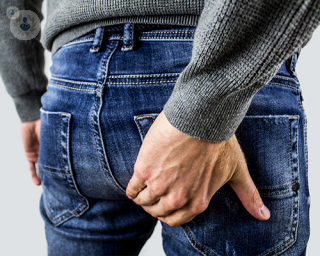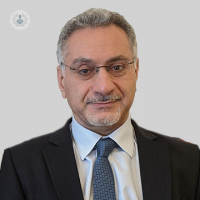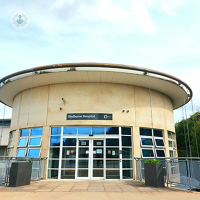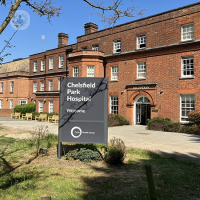Pilonidal sinus
Mr Sebastian Smolarek - Colorectal surgery
Created on: 04-17-2018
Updated on: 08-25-2023
Edited by: Carlota Pano
What is a pilonidal sinus?
A pilonidal sinus is a small tunnel in the skin which can fill with pus or fluid, resulting in either a cyst or abscess. These usually occur in the top of the buttocks where they divide. They do not always produce symptoms, however, if it becomes infected it requires attention. If you are aware of a pilonidal sinus, but it is not infected, it is important to take a ‘watch and wait’ approach.

What are the symptoms of a pilonidal sinus?
If the pilonidal sinus becomes infected, then a cyst or abscess can form, which can cause pain and discomfort particularly when sitting down. Hence, infected pilonidal sinuses are common in people who sit down a lot, such as lorry or taxi drivers.
Signs of an infected pilonidal sinus are:
- swelling, pain and tenderness
- red skin around the cyst
- pain when sitting
- pus
What causes a pilonidal sinus?
The cause of a pilonidal sinus is still unknown, however, it is thought to be caused by a combination of the following:
- Friction from sitting down a lot, which can cause an ingrown hair which leads to a pilonidal sinus forming.
- A change in hormones. Pilonidal sinuses form after puberty.
How can an infected pilonidal sinus be prevented?
It can help to keep the area very clean, and to avoid sitting for long periods of time.
What is the treatment for a pilonidal sinus?
If the infected pilonidal sinus is not too painful or advanced, then antibiotics will be prescribed to fight the infection. However, this treatment does not fully heal the sinus, so after the infection is gone, it is important to keep the area clean and hair-free with frequent shaving.
If the infection is particularly bad, the abscess might be lanced to drain the pus, hair and blood from the sinus. Once it is healed, it is important to pay attention to the site and keep it clean. Depending on the size of the abscess, this procedure will be done either under local or general anaesthetic.
Surgery can also be carried out to remove the sinus altogether. The wound will either be left to heal openly or it will be flattened and closed with stitches. Both have their advantages and disadvantages. Open healing has a lower risk of the sinus returning, however, recovery time is up to 12 weeks. Closed healing has a quicker recovery time, but the chances of infection returning are higher.
















